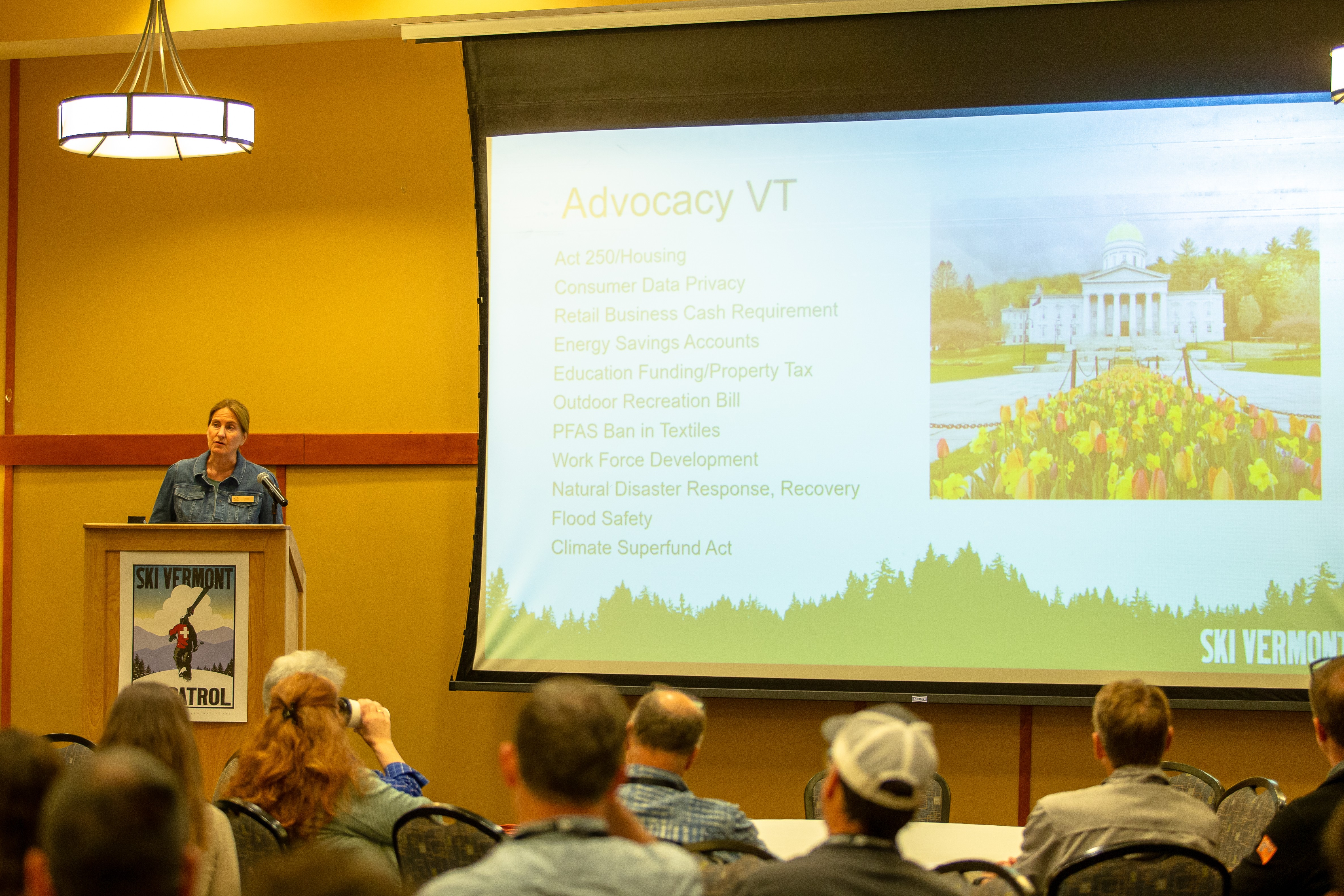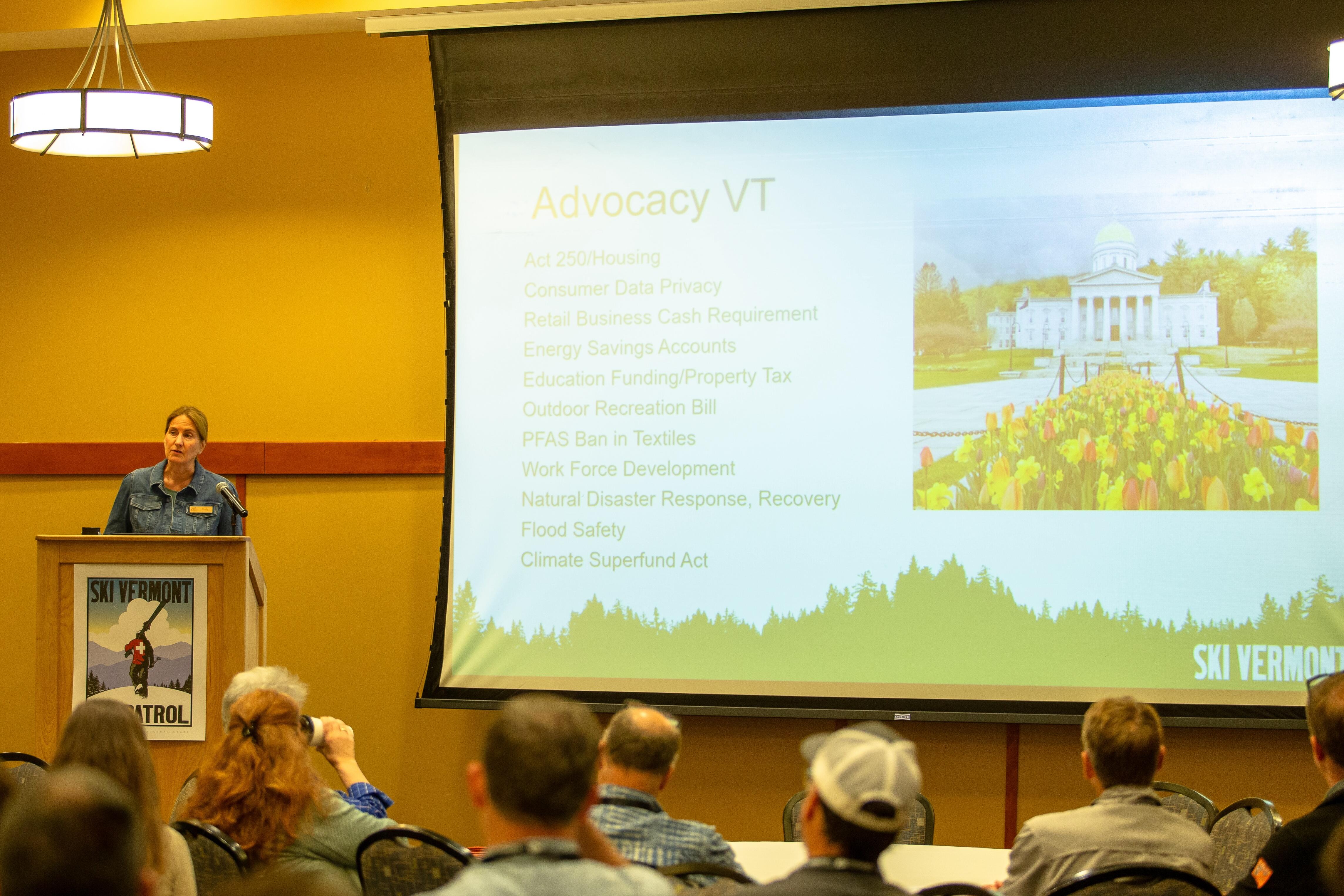
MONTPELIER, Vt. (June 11, 2024) – Vermont’s alpine and cross-country ski area members joined industry partners, supporters, and friends at the Vermont Ski Areas Association's (VSAA) 55th Annual Meeting at Jay PeakResort late last week to recap a challenging but successful season.
Despite facing many weather challenges Vermont’s alpine ski areas reported 4.1 million skier visits for 2023-24, down less than half a percentage point from the 2022-23 season. Visitation this season remains 4 percent above Vermont’s 10-year average and outpaces a 6.2 percent decrease in Northeast region visits (12.4 million) and a 6.6 percent decrease in national visits (60.4 million).
Vermont remains the top ski state in the east and fourth largest in the nation, measured by skier visits, a key performance indicator for the snowsports industry. For the 2023-24 season, the state’s ski areas averaged 124 operating days—one more than the 10-year average, and an average seasonal snowfall of 199 inches—a 32-inch increase over last year, and 15 inches above the 10-year average.
“This is a positive result considering the often-challenging weather, particularly during the first half of the season. Such a slight change in skier visits compared to last year highlights the efficiency and sustainability advances that Vermont’s alpine ski areas have made, particularly in snowmaking operations,” said Ski Vermont president Molly Mahar. “Aggressive investment in new technology, agile and flexible operations and hard work delivered the conditions to keep skiers visiting this season – important not only to ski areas but also for all the businesses that rely on strong skier turnout for their own success.” (cont'd below)
*Photos courtesy of Red Vault Productions
After a slow start and inconsistent weather for two of the three peak visitation periods, late-season snowstorms and the total solar eclipse helped boost ski area visits in March and April for a strong end to the season. Ski areas operating in the path of totality reported 100 percent occupancy and strong visitation, and all across the state many guests took advantage of the late-season snow. Several areas also extended their seasons, with Jay Peak and Sugarbush skiing into May and Killington again skiing into June to offer the longest season in the East.
Ski Vermont’s 26 cross country ski area members reported a statewide total of 202,485 skier visits, a decrease of 49.6 percent from the previous season. Cross-country ski areas are more heavily dependent on natural snowfall and some areas were not able to open until the second week in January. Some areas reported that the decrease in revenue was not commensurate with skier visits thanks to season pass sales and other revenue streams.
VSAA’s Annual Meeting addressed a range of important topics, with speakers including Vermont State Treasurer Mike Pieciak, Commissioner of the Department of Tourism and Marketing Heather Pelham, National Ski Areas Association President & CEO Kelly Pawlak, Co-Founder of the Snow Angel Foundation Chauncy Johnson, and keynote speakers Kevin Chu, Director of the Vermont Futures Project and Tino Rutanhira, Co-Founder of the Vermont Professionals of Color Network, presenting research and perspectives on the present and future potential of Vermont’s population.
VSAA presented Industry Achievement Awards to Mike Hussey, former General Manager of Middlebury Snow Bowl and Rikert Outdoor Center, and to Bill Cairns, former president and general manager of Bromley Mountain. Friend of the Industry Awards were presented to Jeff Nelson of VHB and to Betsy Bishop, president of the Vermont Chamber of Commerce. Career employee awards went to Patti Martin and Donna Barton of Stowe Mountain Resort and Deirdre Morris of Killington Resort.
Skiing is an important economic driver and employer in the state, particularly in rural areas where many ski areas are located. Ski Vermont’s Fifth Grade Passport helps to get approximately 3,000 children on the slopes annually and partial proceeds from the program support Vermont Adaptive Ski and Sports.
###
A non-profit trade association founded in 1969 to serve alpine and cross-country ski areas, the Vermont Ski Areas Association (Ski Vermont) is a proud ambassador of the thriving winter tourism industry in Vermont, where skiing and snowboarding are the official state winter sports. The top ski state in the east and among the top destinations in the US, Vermont boasts world-class snowmaking quality, coverage, and efficiency, a wide variety of terrain, and profound historical impact on the sports of skiing and snowboarding - making it one of the most significant ski and ride destinations in the world. VSAA’s mission is to help maintain an environment in which the state’s ski areas can prosper. Ski Vermont serves its 21 Alpine and 26 Cross Country member resorts in three major areas: Governmental Affairs, Marketing and Public Affairs.
